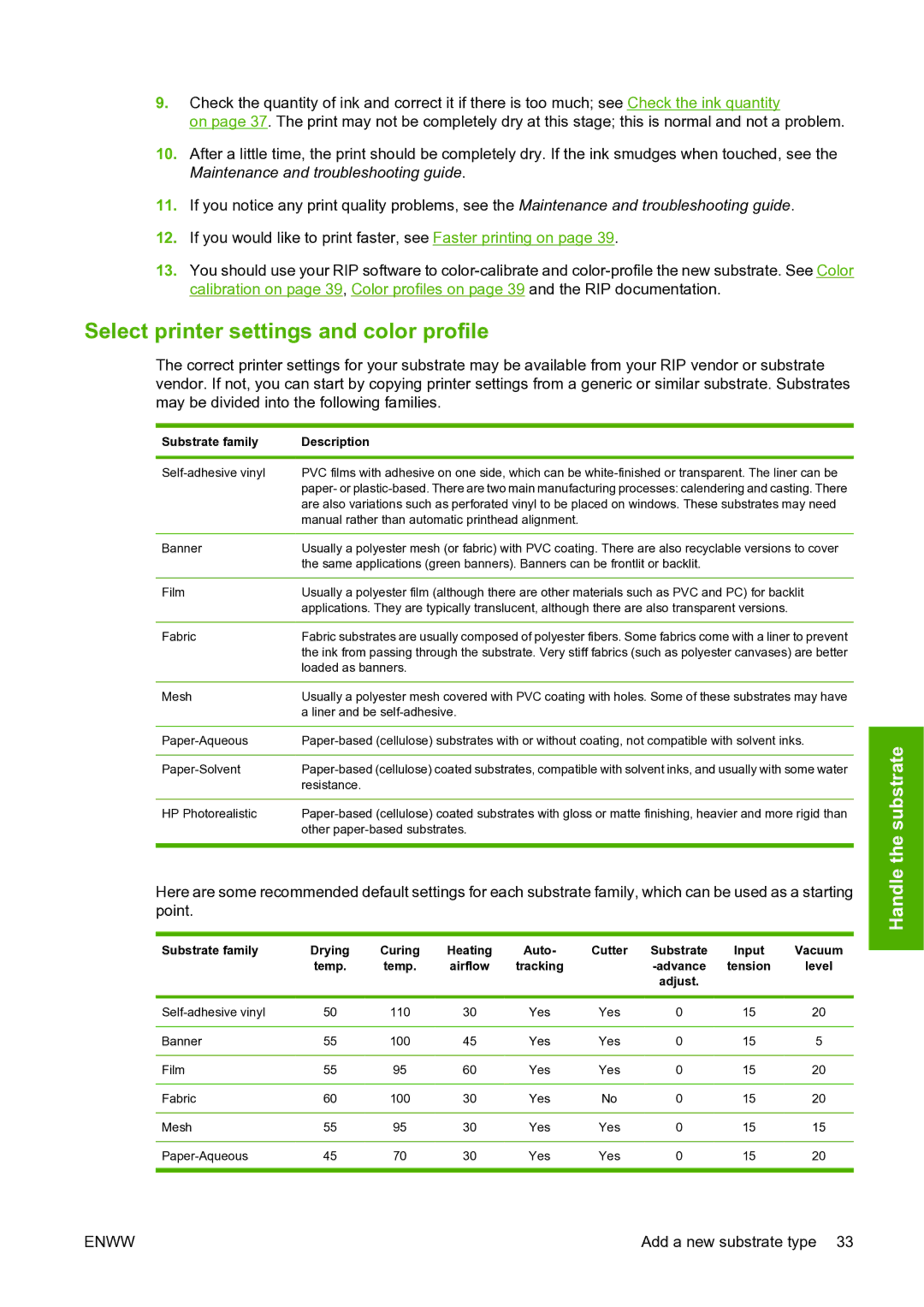
9.Check the quantity of ink and correct it if there is too much; see Check the ink quantity
on page 37. The print may not be completely dry at this stage; this is normal and not a problem.
10.After a little time, the print should be completely dry. If the ink smudges when touched, see the Maintenance and troubleshooting guide.
11.If you notice any print quality problems, see the Maintenance and troubleshooting guide.
12.If you would like to print faster, see Faster printing on page 39.
13.You should use your RIP software to
Select printer settings and color profile
The correct printer settings for your substrate may be available from your RIP vendor or substrate vendor. If not, you can start by copying printer settings from a generic or similar substrate. Substrates may be divided into the following families.
Substrate family | Description |
|
|
| PVC films with adhesive on one side, which can be |
| paper- or |
| are also variations such as perforated vinyl to be placed on windows. These substrates may need |
| manual rather than automatic printhead alignment. |
|
|
Banner | Usually a polyester mesh (or fabric) with PVC coating. There are also recyclable versions to cover |
| the same applications (green banners). Banners can be frontlit or backlit. |
|
|
Film | Usually a polyester film (although there are other materials such as PVC and PC) for backlit |
| applications. They are typically translucent, although there are also transparent versions. |
|
|
Fabric | Fabric substrates are usually composed of polyester fibers. Some fabrics come with a liner to prevent |
| the ink from passing through the substrate. Very stiff fabrics (such as polyester canvases) are better |
| loaded as banners. |
|
|
Mesh | Usually a polyester mesh covered with PVC coating with holes. Some of these substrates may have |
| a liner and be |
|
|
|
|
| resistance. |
|
|
HP Photorealistic | |
| other |
|
|
Here are some recommended default settings for each substrate family, which can be used as a starting point.
Substrate family | Drying | Curing | Heating | Auto- | Cutter | Substrate | Input | Vacuum |
| temp. | temp. | airflow | tracking |
| tension | level | |
|
|
|
|
|
| adjust. |
|
|
|
|
|
|
|
|
|
|
|
50 | 110 | 30 | Yes | Yes | 0 | 15 | 20 | |
|
|
|
|
|
|
|
|
|
Banner | 55 | 100 | 45 | Yes | Yes | 0 | 15 | 5 |
|
|
|
|
|
|
|
|
|
Film | 55 | 95 | 60 | Yes | Yes | 0 | 15 | 20 |
|
|
|
|
|
|
|
|
|
Fabric | 60 | 100 | 30 | Yes | No | 0 | 15 | 20 |
|
|
|
|
|
|
|
|
|
Mesh | 55 | 95 | 30 | Yes | Yes | 0 | 15 | 15 |
|
|
|
|
|
|
|
|
|
45 | 70 | 30 | Yes | Yes | 0 | 15 | 20 | |
|
|
|
|
|
|
|
|
|
Handle the substrate
ENWW | Add a new substrate type 33 |
